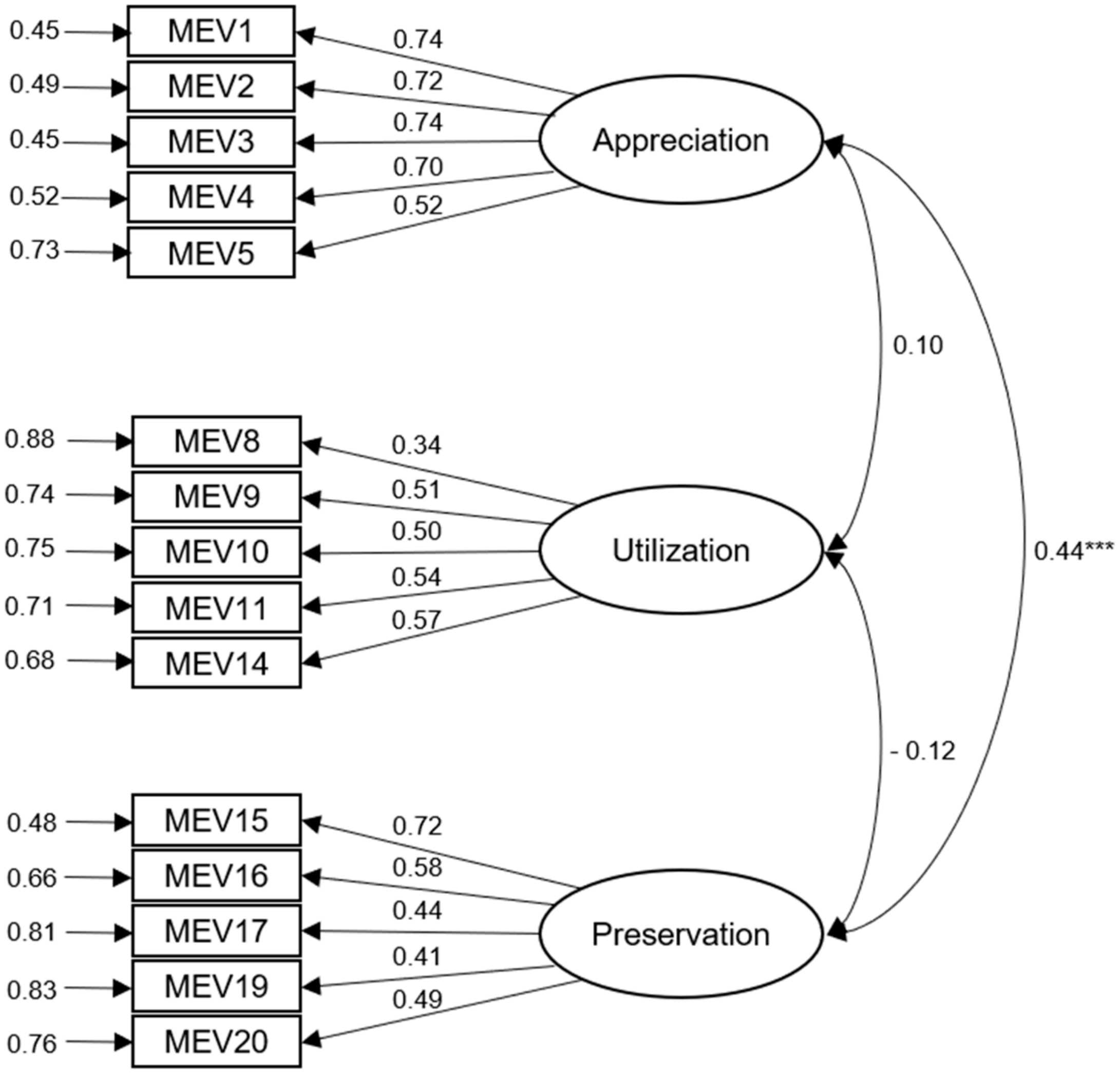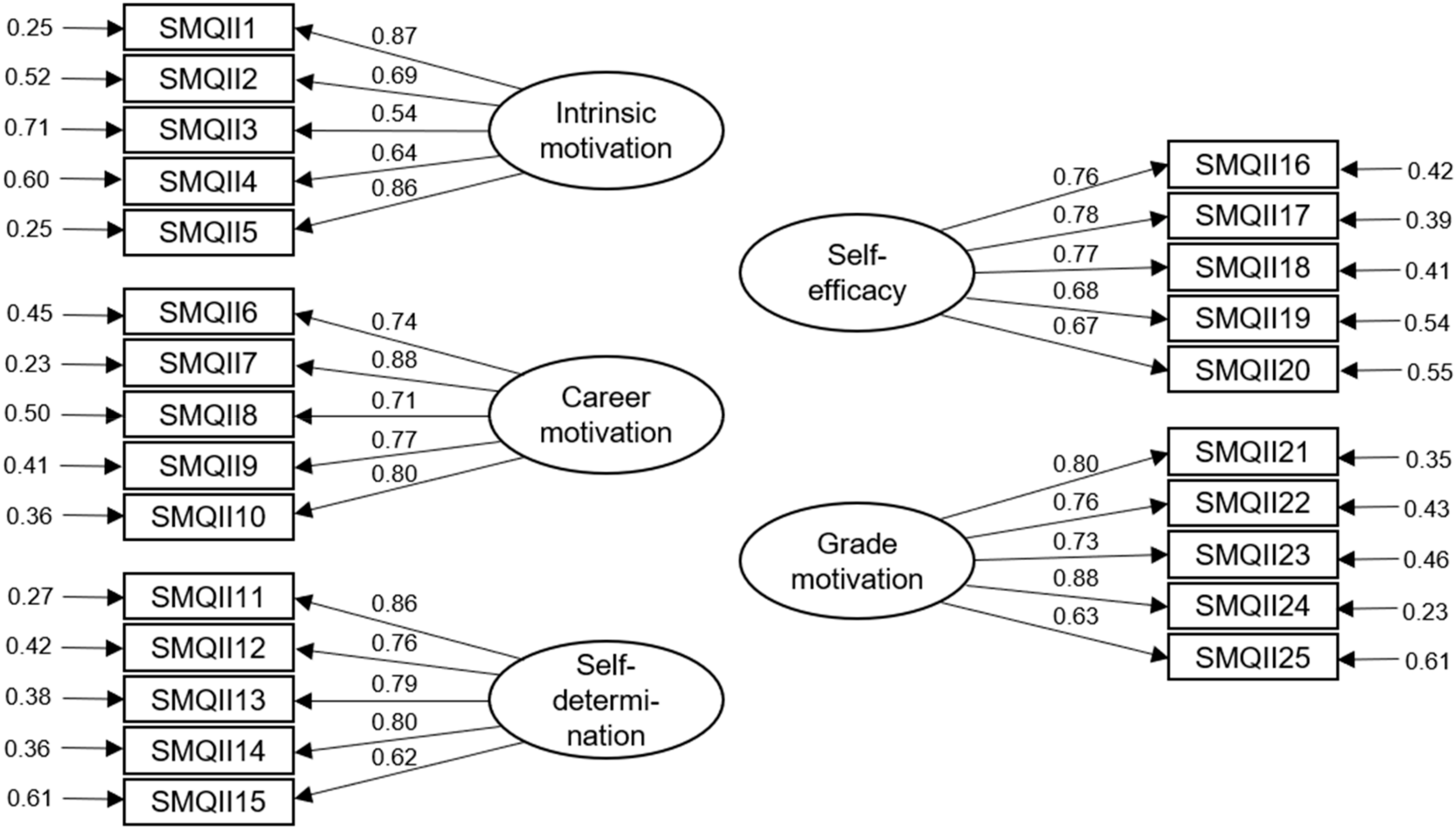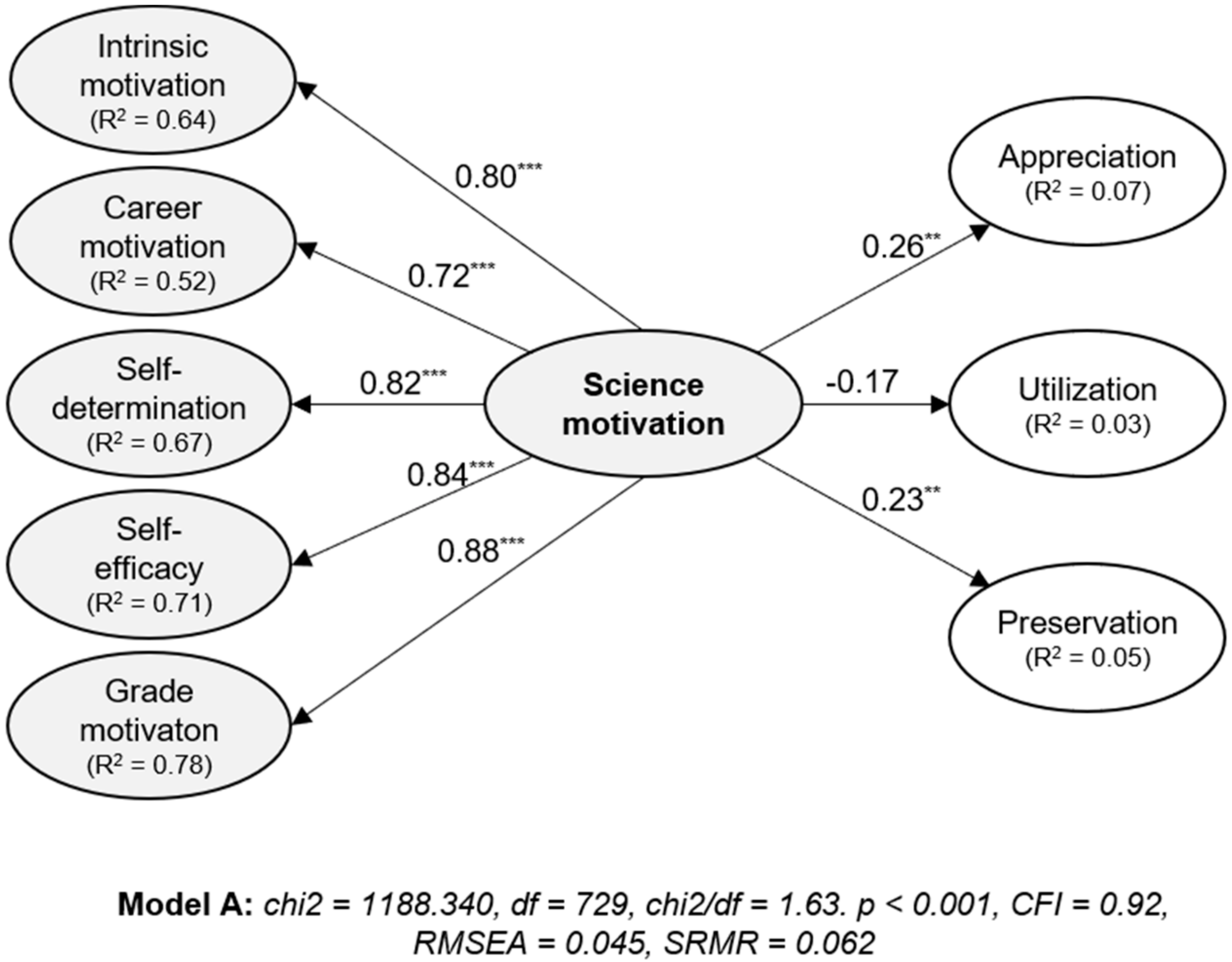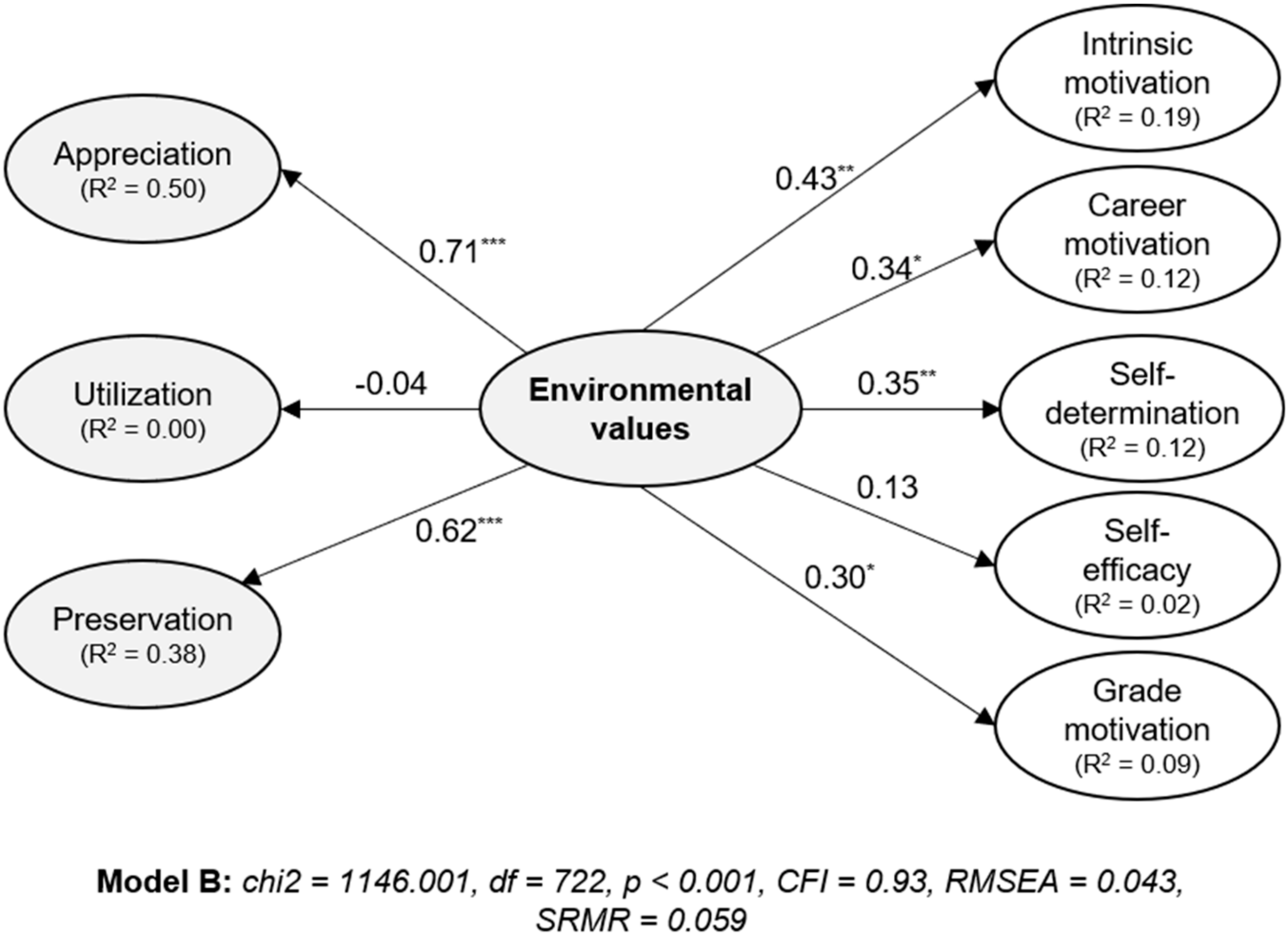Between Science Education and Environmental Education: How Science Motivation Relates to Environmental Values
Abstract
1. Introduction
1.1. Science Motivation
1.2. Environmental Attitudes
1.3. Purpose
2. Materials and Methods
2.1. Sample
2.2. Measures
2.3. Statistical Analyses
3. Results
3.1. Measuring Environmental Values
3.2. Measuring Science Motivation
3.3. Science Motivation and Environmental Values
4. Discussion
4.1. Students’ Motivation to Learn Science
4.2. Students’ Environmental Values
4.3. Relationship between Science Motivation and Environmental Values
5. Conclusions
Author Contributions
Funding
Acknowledgments
Conflicts of Interest
References
- Dillon, J. 50 Years of JBE: From Science and Environmental Education to Civic Science. J. Biol. Educ. 2016, 50, 120–122. [Google Scholar] [CrossRef]
- Wals, A.E.J.; Brody, M.; Dillon, J.; Stevenson, R.B. Convergence between science and environmental education. Science 2014, 344, 583–584. [Google Scholar] [CrossRef] [PubMed]
- Gough, A. The emergence of environmental education research. In International Handbook of Research on Environmental Education; Routledge: New York, NY, USA, 2013; pp. 13–23. [Google Scholar]
- Gough, A. Mutualism: A different agenda for environmental and science education. Int. J. Sci. Educ. 2002, 24, 1201–1215. [Google Scholar] [CrossRef]
- UNESCO. The Belgrade charter on environmental education. Connect UNESCO-UNEP Environ. Educ. Newsl. 1976, 6, 135–136. [Google Scholar]
- UNESCO; UNEP. The Tbilisi Declaration. In Intergovernmental Conference on Environmental Education; UNESCO: Tbilisi, Georgia, 1977; pp. 14–26. [Google Scholar]
- Osborne, J.; Simon, S.; Collins, S. Attitudes towards science: A review of the literature and its implications. Int. J. Sci. Educ. 2003, 25, 1049–1079. [Google Scholar] [CrossRef]
- Potvin, P.; Hasni, A. Interest, motivation and attitude towards science and technology at K-12 levels: A systematic review of 12 years of educational research. Stud. Sci. Educ. 2014, 50, 85–129. [Google Scholar] [CrossRef]
- Glynn, S.M.; Brickman, P.; Armstrong, N.; Taasoobshirazi, G. Science motivation questionnaire II: Validation with science majors and nonscience majors. J. Res. Sci. Teach. 2011, 48, 1159–1176. [Google Scholar] [CrossRef]
- Bandura, A. Social Foundations of Thought and Action: A Social Cognitive Theory; Prentice-Hall, Inc.: Upper Saddle River, NJ, USA, 1986; ISBN 013815614X. [Google Scholar]
- Ryan, R.M.; Deci, E.L. Intrinsic and Extrinsic Motivations: Classic Definitions and New Directions. Contemp. Educ. Psychol. 2000, 25, 54–67. [Google Scholar] [CrossRef]
- Schunk, D.H.; Pintrich, P.R.; Meece, J.R. Motivation in Education: Theory, Research, and Applications; Pearson/Merrill Prentice Hall: Upper Saddle River, NJ, USA, 2008; ISBN 9780132281553. [Google Scholar]
- Black, A.E.; Deci, E.L. The Effects of Instructors’ Autonomy Support and Students’ Autonomous Motivation on Learning. Sci. Educ. 2000, 84, 740. [Google Scholar] [CrossRef]
- Pajares, F. Gender and perceived self-efficacy in self-regulated learning. Theory Pract. 2002, 41, 116–125. [Google Scholar] [CrossRef]
- Lovelace, M.; Brickman, P. Best practices for measuring students’ attitudes toward learning science. CBE Life Sci. Educ. 2013, 12, 606–617. [Google Scholar] [CrossRef] [PubMed][Green Version]
- Deci, E.L.; Ryan, R.M. Self-determination theory: A macrotheory of human motivation, development, and health. Can. Psychol. 2008, 49, 182–185. [Google Scholar] [CrossRef]
- Schumm, M.F.; Bogner, F.X. Measuring adolescent science motivation. Int. J. Sci. Educ. 2016, 38, 434–449. [Google Scholar] [CrossRef]
- Salta, K.; Koulougliotis, D. Assessing motivation to learn chemistry: Adaptation and validation of Science Motivation Questionnaire II with Greek secondary school students. Chem. Educ. Res. Pract. 2015, 16, 237–250. [Google Scholar] [CrossRef]
- Schumm, M.F.; Bogner, F.X. The impact of science motivation on cognitive achievement within a 3-lesson unit about renewable energies. Stud. Educ. Eval. 2016, 50, 14–21. [Google Scholar] [CrossRef]
- Singh, K.; Granville, M.; Dika, S. Mathematics and Science Achievement: Effects of Motivation, Interest, and Academic Engagement. J. Educ. Res. 2002, 95, 323–332. [Google Scholar] [CrossRef]
- Velayutham, S.; Aldridge, J.; Fraser, B. Development and validation of an instrument to measure students’ motivation and self-regulation in science learning. Int. J. Sci. Educ. 2011, 33, 2159–2179. [Google Scholar] [CrossRef]
- Zeyer, A. Motivation to Learn Science and Cognitive Style. Eurasia J. Math. Sci. Technol. Educ. 2010, 6, 121–128. [Google Scholar] [CrossRef]
- Tuan, H.L.; Chin, C.C.; Shieh, S.H. The development of a questionnaire to measure students’ motivation towards science learning. Int. J. Sci. Educ. 2005, 27, 639–654. [Google Scholar] [CrossRef]
- Potter, G. Environmental Education for the 21st Century: Where Do We Go Now? J. Environ. Educ. 2009, 41, 22–33. [Google Scholar] [CrossRef]
- Roczen, N.; Kaiser, F.G.; Bogner, F.X.; Wilson, M. A competence model for environmental education. Environ. Behav. 2014, 46, 972–992. [Google Scholar] [CrossRef]
- Mayer, F.S.; Frantz, C.M.P. The connectedness to nature scale: A measure of individuals’ feeling in community with nature. J. Environ. Psychol. 2004, 24, 503–515. [Google Scholar] [CrossRef]
- Varela-Losada, M.; Vega-Marcote, P.; Pérez-Rodríguez, U.; Álvarez-Lires, M. Going to action? A literature review on educational proposals in formal Environmental Education. Environ. Educ. Res. 2016, 22, 390–421. [Google Scholar] [CrossRef]
- Fančovičová, J.; Prokop, P. Plants have a chance: Outdoor educational programmes alter students’ knowledge and attitudes towards plants. Environ. Educ. Res. 2011, 17, 537–551. [Google Scholar] [CrossRef]
- Schönfelder, M.L.; Bogner, F.X. Two ways of acquiring environmental knowledge: By encountering living animals at a beehive and by observing bees via digital tools. Int. J. Sci. Educ. 2017, 39, 723–741. [Google Scholar] [CrossRef]
- Bogner, F.X. The influence of short-term outdoor ecology education on long-term variables of environmental perspective. J. Environ. Educ. 1998, 29, 17–29. [Google Scholar] [CrossRef]
- Johnson, B.; Manoli, C.C. The 2-MEV Scale in the United States: A measure of children’s environmental attitudes based on the theory of ecological attitude. J. Environ. Educ. 2010, 42, 84–97. [Google Scholar] [CrossRef]
- Fremerey, C.; Bogner, F.X. Cognitive learning in authentic environments in relation to green attitude preferences. Stud. Educ. Eval. 2015, 44, 9–15. [Google Scholar] [CrossRef]
- Bogner, F.X.; Wiseman, M. Adolescents’ attitudes towards nature and environment: Quantifying the 2-MEV model. Environmentalist 2006, 26, 247–254. [Google Scholar] [CrossRef]
- Bogner, F.X.; Wiseman, M. Toward Measuring Adolescent Environmental Perception. Eur. Psychol. 1999, 4, 139–151. [Google Scholar] [CrossRef]
- Kibbe, A.; Bogner, F.X.; Kaiser, F.G. Exploitative vs. appreciative use of nature—Two interpretations of utilization and their relevance for environmental education. Stud. Educ. Eval. 2014, 41, 106–112. [Google Scholar] [CrossRef]
- Bogner, F.X. Environmental Values (2-MEV) and Appreciation of Nature. Sustainability 2018, 10, 350. [Google Scholar] [CrossRef]
- Brügger, A.; Kaiser, F.G.; Roczen, N. One for All? Eur. Psychol. 2011, 16, 324–333. [Google Scholar] [CrossRef]
- Raab, P.; Randler, C.; Bogner, F. How Young “Early Birds” Prefer Preservation, Appreciation and Utilization of Nature. Sustainability 2018, 10, 4000. [Google Scholar] [CrossRef]
- Beauducel, A.; Wittmann, W.W. Simulation Study on Fit Indexes in CFA Based on Data with Slightly Distorted Simple Structure. Struct. Equ. Model. A Multidiscip. J. 2005, 12, 41–75. [Google Scholar] [CrossRef]
- Browne, M.W.; Cudeck, R. Alternative Ways of Assessing Model Fit. Sociol. Methods Res. 1992, 21, 230–258. [Google Scholar] [CrossRef]
- Hooper, D.; Coughlan, J.; Mullen, M. Structural equation modelling: Guidelines for determining model fit. Electron. J. Bus. Res. Methods 2008, 6, 53–59. [Google Scholar]
- Field, A.; Miles, J.; Field, Z. Discovering Statistics Using R, 1st ed.; SAGE Publications, Ltd.: London, UK, 2012; ISBN 978-1-4462-0045-2. [Google Scholar]
- Cohen, J. A power primer. Psychol. Bull. 1992, 112, 155–159. [Google Scholar] [CrossRef]
- Bagozzi, R.P.; Yi, Y. Specification, evaluation, and interpretation of structural equation models. J. Acad. Mark. Sci. 2012, 40, 8–34. [Google Scholar] [CrossRef]
- Gatignon, H. Statistical Analysis of Management Data; Springer: New York, NY, USA, 2010; ISBN 978-1-4419-1269-5. [Google Scholar]
- Kline, P. The Handbook of Psychological Testing/Paul Kline; Routledge: London, UK, 1999; ISBN 00071269. [Google Scholar]
- Cleveland, L.M.; Olimpo, J.T.; DeChenne-Peters, S.E. Investigating the relationship between instructors’ use of active-learning strategies and students’ conceptual understanding and affective changes in introductory biology: A comparison of two active-learning environments. CBE Life Sci. Educ. 2017, 16, 1–10. [Google Scholar] [CrossRef]
- Austin, A.C.; Hammond, N.B.; Barrows, N.; Gould, D.L.; Gould, I.R. Relating motivation and student outcomes in general organic chemistry. Chem. Educ. Res. Pract. 2018, 19, 331–341. [Google Scholar] [CrossRef]
- Ardura, D.; Pérez-Bitrián, A. The effect of motivation on the choice of chemistry in secondary schools: Adaptation and validation of the Science Motivation Questionnaire II to Spanish students. Chem. Educ. Res. Pract. 2018, 19, 905–918. [Google Scholar] [CrossRef]
- Lepper, M.R.; Corpus, J.H.; Iyengar, S.S. Intrinsic and extrinsic motivational orientations in the classroom: Age differences and academic correlates. J. Educ. Psychol. 2005, 97, 184–196. [Google Scholar] [CrossRef]
- Bandura, A. Social Learning Theory; Prentice Hall: Englewood Cliffs, NJ, USA, 1977. [Google Scholar]
- Ceci, S.; Williams, W. Why Aren’t More Women in Science. Top Researchers Debate the Evidence; American Psychological Association: Washington, DC, USA, 2007. [Google Scholar]
- Meece, J.L.; Courtney, D.P. Gender Differences in Students’ Percepions: Consequences for Achievement-Related Choices. In Student Perceptions in the Classroom; Lawrence Erlbaum Associates: Hillsdale, NJ, USA, 1992; pp. 209–228. [Google Scholar]
- Vedder-Weiss, D.; Fortus, D. Adolescents’ declining motivation to learn science: A follow-up study. J. Res. Sci. Teach. 2012, 49, 1057–1095. [Google Scholar] [CrossRef]
- Kaiser, F.G.; Hartig, T.; Brügger, A.; Duvier, C. Environmental Protection and Nature as Distinct Attitudinal Objects: An Application of the Campbell Paradigm. Environ. Behav. 2013, 45, 369–398. [Google Scholar] [CrossRef]
- Schneller, A.J.; Johnson, B.; Bogner, F.X. Measuring children’s environmental attitudes and values in northwest Mexico: Validating a modified version of measures to test the Model of Ecological Values (2-MEV). Environ. Educ. Res. 2015, 21, 61–75. [Google Scholar] [CrossRef]
- Zelezny, L.; Chua, P.; Aldrich, C. Elaborating on Gender Differences in Environmentalism. J. Soc. Issues 2000, 56, 443–457. [Google Scholar] [CrossRef]
- Milfont, T.L.; Duckitt, J. The structure of environmental attitudes: A first- and second-order confirmatory factor analysis. J. Environ. Psychol. 2004, 24, 289–303. [Google Scholar] [CrossRef]
- Hidi, S.; Harackiewicz, J.M. Motivating the Academically Unmotivated: A Critical Issue for the 21st Century. Rev. Educ. Res. 2007, 70, 151–179. [Google Scholar] [CrossRef]
- UN General Assembly. Transforming Our World: The 2030 Agenda for Sustainable Development. A/RES/70/1; UN General Assembly: New York, NY, USA, 2015. [Google Scholar]




| chi2 | df | chi2/df | CFI | RMSEA | SRMR | ||
|---|---|---|---|---|---|---|---|
| Environmental values | |||||||
| 1 Original model | (APR, UTL, PRE) | 186 | 87 | 2.14 | 0.91 | 0.056 | 0.058 |
| 1a One-factor model | (APR/UTL/PRE) | 462 | 90 | 5.13 | 0.63 | 0.110 | 0.104 |
| 1b Two-factor model | (APR/PRE, UTL) | 329 | 89 | 3.70 | 0.76 | 0.088 | 0.084 |
| Science motivation | |||||||
| 2 Original model | 530 | 265 | 2.00 | 0.94 | 0.057 | 0.051 | |
| Boys | Girls | |||||||
|---|---|---|---|---|---|---|---|---|
| M | SE | M | SE | t | df | p | r | |
| Environmental values | ||||||||
| Appreciation | −0.15 | 0.05 | 0.31 | 0.08 | −4.90 | 387 | 0.000 *** | 0.24 |
| Utilization | −0.02 | 0.02 | 0.05 | 0.02 | −2.35 | 387 | 0.019 * | 0.12 |
| Preservation | −0.08 | 0.04 | 0.17 | 0.06 | −3.45 | 387 | 0.006** | 0.17 |
| Science motivation | ||||||||
| Intrinsic motivation | 0.11 | 0.05 | −0.22 | 0.10 | 2.89 | 194.26 | 0.004 ** | 0.20 |
| Career motivation | 0.06 | 0.05 | −0.13 | 0.08 | 2.08 | 209.72 | 0.038 * | 0.14 |
| Self-determination | 0.02 | 0.05 | −0.05 | 0.10 | 0.66 | 205.74 | 0.508 | |
| Self-efficacy | 0.13 | 0.05 | −0.26 | 0.10 | 3.46 | 185.16 | 0.002 ** | 0.25 |
| Grade motivation | 0.08 | 0.05 | −0.16 | 0.09 | 2.26 | 198.05 | 0.024 * | 0.16 |
| Science Motivation | Intrinsic Motivation | Career Motivation | Self-Determination | Self-Efficacy | Grade Motivation |
|---|---|---|---|---|---|
| Intrinsic motivation | 1.00 | 0.71 *** | 0.61 *** | 0.67 *** | 0.65 *** |
| Career motivation | 1.00 | 0.54 *** | 0.60 *** | 0.62 *** | |
| Self-determination | 1.00 | 0.71 *** | 0.77 *** | ||
| Self-efficacy | 1.00 | 0.76 *** | |||
| Grade motivation | 1.00 |
© 2020 by the authors. Licensee MDPI, Basel, Switzerland. This article is an open access article distributed under the terms and conditions of the Creative Commons Attribution (CC BY) license (http://creativecommons.org/licenses/by/4.0/).
Share and Cite
Schönfelder, M.L.; Bogner, F.X. Between Science Education and Environmental Education: How Science Motivation Relates to Environmental Values. Sustainability 2020, 12, 1968. https://doi.org/10.3390/su12051968
Schönfelder ML, Bogner FX. Between Science Education and Environmental Education: How Science Motivation Relates to Environmental Values. Sustainability. 2020; 12(5):1968. https://doi.org/10.3390/su12051968
Chicago/Turabian StyleSchönfelder, Mona L., and Franz X. Bogner. 2020. "Between Science Education and Environmental Education: How Science Motivation Relates to Environmental Values" Sustainability 12, no. 5: 1968. https://doi.org/10.3390/su12051968
APA StyleSchönfelder, M. L., & Bogner, F. X. (2020). Between Science Education and Environmental Education: How Science Motivation Relates to Environmental Values. Sustainability, 12(5), 1968. https://doi.org/10.3390/su12051968





